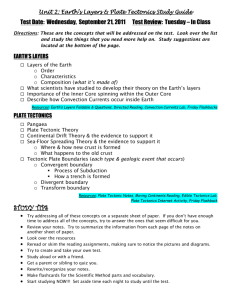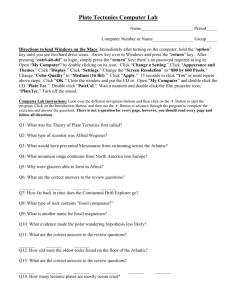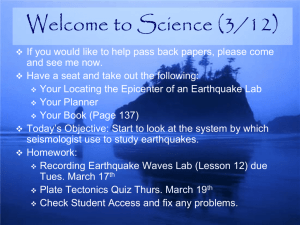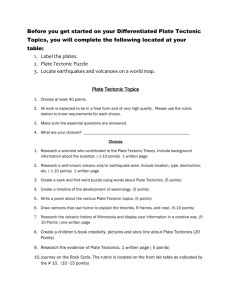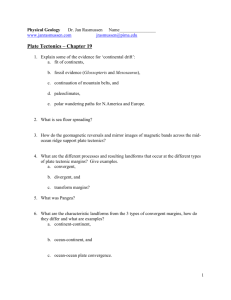Page 1 of 3 Discussion: Professor: Aaron Yoshinobu
advertisement
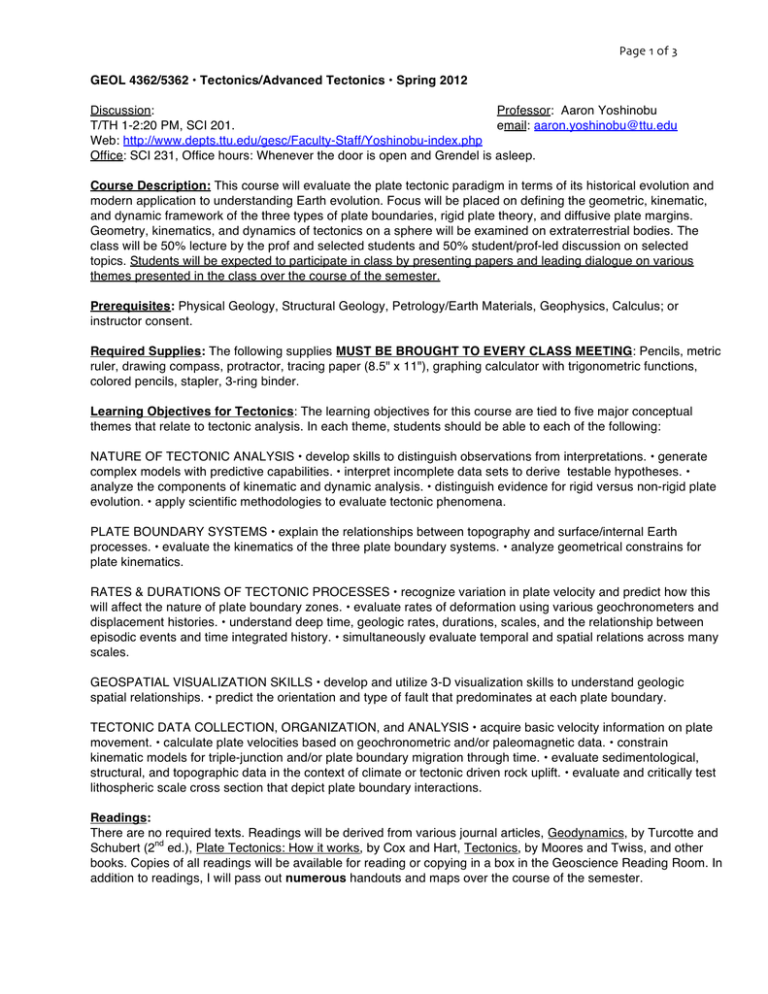
Page 1 of 3 GEOL 4362/5362 • Tectonics/Advanced Tectonics • Spring 2012 Discussion: Professor: Aaron Yoshinobu T/TH 1-2:20 PM, SCI 201. email: aaron.yoshinobu@ttu.edu Web: http://www.depts.ttu.edu/gesc/Faculty-Staff/Yoshinobu-index.php Office: SCI 231, Office hours: Whenever the door is open and Grendel is asleep. Course Description: This course will evaluate the plate tectonic paradigm in terms of its historical evolution and modern application to understanding Earth evolution. Focus will be placed on defining the geometric, kinematic, and dynamic framework of the three types of plate boundaries, rigid plate theory, and diffusive plate margins. Geometry, kinematics, and dynamics of tectonics on a sphere will be examined on extraterrestrial bodies. The class will be 50% lecture by the prof and selected students and 50% student/prof-led discussion on selected topics. Students will be expected to participate in class by presenting papers and leading dialogue on various themes presented in the class over the course of the semester. Prerequisites: Physical Geology, Structural Geology, Petrology/Earth Materials, Geophysics, Calculus; or instructor consent. Required Supplies: The following supplies MUST BE BROUGHT TO EVERY CLASS MEETING: Pencils, metric ruler, drawing compass, protractor, tracing paper (8.5" x 11"), graphing calculator with trigonometric functions, colored pencils, stapler, 3-ring binder. Learning Objectives for Tectonics: The learning objectives for this course are tied to five major conceptual themes that relate to tectonic analysis. In each theme, students should be able to each of the following: NATURE OF TECTONIC ANALYSIS!• develop skills to distinguish observations from interpretations.!• generate complex models with predictive capabilities.!• interpret incomplete data sets to derive testable hypotheses.!• analyze the components of kinematic and dynamic analysis.!• distinguish evidence for rigid versus non-rigid plate evolution.!• apply scientific methodologies to evaluate tectonic phenomena. PLATE BOUNDARY SYSTEMS!• explain the relationships between topography and surface/internal Earth processes.!• evaluate the kinematics of the three plate boundary systems.!• analyze geometrical constrains for plate kinematics. RATES & DURATIONS OF TECTONIC PROCESSES!• recognize variation in plate velocity and predict how this will affect the nature of plate boundary zones.!• evaluate rates of deformation using various geochronometers and displacement histories.!• understand deep time, geologic rates, durations, scales, and the relationship between episodic events and time integrated history.!• simultaneously evaluate temporal and spatial relations across many scales. GEOSPATIAL VISUALIZATION SKILLS!• develop and utilize 3-D visualization skills to understand geologic spatial relationships.!• predict the orientation and type of fault that predominates at each plate boundary. TECTONIC DATA COLLECTION, ORGANIZATION, and ANALYSIS!• acquire basic velocity information on plate movement.!• calculate plate velocities based on geochronometric and/or paleomagnetic data.!• constrain kinematic models for triple-junction and/or plate boundary migration through time.!• evaluate sedimentological, structural, and topographic data in the context of climate or tectonic driven rock uplift.!• evaluate and critically test lithospheric scale cross section that depict plate boundary interactions. Readings: There are no required texts. Readings will be derived from various journal articles, Geodynamics, by Turcotte and nd Schubert (2 ed.), Plate Tectonics: How it works, by Cox and Hart, Tectonics, by Moores and Twiss, and other books. Copies of all readings will be available for reading or copying in a box in the Geoscience Reading Room. In addition to readings, I will pass out numerous handouts and maps over the course of the semester. Page 2 of 3 Assessments & Assignments: All of the assessments will be used in four ways: 1) to engage students; 2) to assess student learning after content delivery; 3) to evaluate whether or not learning objectives were met by comparing pre- and post-test results; and 4) to assign grades. Possible Assessment Types:! Tests (midterm exam, final exam); Homework assignments; Presentations; Final Presentation Final Paper You will be given prior warning of tests and due dates. However, you may not receive any warning for other assessments; therefore, it is imperative that you not miss a single class meeting. Assessments will be reasonable in length and expectation. All assessments will be derived from discussion and reading material. Grading: TTU Operating Policy states that an "A" is excellent work, "B" is good work, "C" is average work, "D" is inferior (but not necessarily passing degree requirements), and "F" is failing to meet degree requirements. Specific grading rubrics may be handed out with various assignments. All assignments are due at the beginning of class one week after they are assigned unless otherwise noted. See “General Grading Rubric” for details on how you are assessed in this course. LATE WORK WILL NOT BE ACCEPTED. TTU Operating Policies relating to course syllabi: Student Absence for Observance of Religious Holy Day (OP 34.19) 1. "Religious holy day" means a holy day observed by a religion whose places of worship are exempt from property taxation under Texas Tax Code §11.20. 2. A student who intends to observe a religious holy day should make that intention known in writing to the instructor prior to the absence. A student who is absent from classes for the observance of a religious holy day shall be allowed to take an examination or complete an assignment scheduled for that day within a reasonable time after the absence. 3. A student who is excused under section 2 may not be penalized for the absence; however, the instructor may respond appropriately if the student fails to complete the assignment satisfactorily. Americans with Disabilities Act (ADA) and Section 504 of the Rehabilitation Act (OP 10.08) Any student who, because of a disability, may require special arrangements in order to meet the course requirements should contact the instructor as possible to make necessary arrangements. Students must present appropriate verification from Student Disability Services during the instructorʼs office hours. Please note that instructors are not allowed to provide classroom accommodation to a student until appropriate verification from Student Disability Services has been provided. For additional information, please contact Student Disability Services office in 335 West Hall or call 806-742-2405. Faculty members are required to announce the following within the first two class periods: "I would appreciate hearing from anyone who has a disability that may require special accommodation. I am sure we can work out whatever arrangements are necessary. Please make an appointment with me during my office hours." Academic Honesty & Integrity (OP 34.12) From OP 34.12: “It is the aim of the faculty of Texas Tech University to foster a spirit of complete honesty and high standard of integrity. The attempt of students to present as their own any work not honestly performed is regarded by the faculty and administration as a most serious offense and renders the offenders liable to serious consequences, possibly suspension. “Scholastic dishonesty” includes, but it not limited to, cheating, plagiarism, collusion, falsifying academic records, misrepresenting facts, and any act designed to give unfair academic advantage to the student (such as, but not limited to, submission of essentially the same written assignment for two courses without the prior permission of the instructor) or the attempt to commit such an act.” For additional information refer to TTU OP: http://www.depts.ttu.edu/opmanual/ Page 3 of 3 TENTATIVE Tectonics 4362/5362 • Spring 2012 Content Syllabus review, Introduction to Plate Tectonics How did we get here? Pre-Plate Tectonic Ideas for Earth Evolution. Sea Floor Spreading, Mid-Ocean Ridges, Ophiolites, & Harry Hess Geometry & Kinematics of Plate Tectonics – WJ Morgan Seismology + Arcs = Subduction Zones Plate Boundaries in Detail – Transform Faults Plate Boundaries In Detail – Rifts and Oceanic Spreading Centers Plate Boundaries in Detail – Convergent Boundaries - Subduction zones - Collision belts - Fold & thrust belts Exhumation, Erosion, Extension, Denudation, Deformation, Intraplate Deformation – Did Morgan have it all wrong?!?!?!?! Or, can GPS tell us more than which way to the closest Starbucks? Hot Spots – Plumes – Bic Lighters Tectonics is not unique to Earth. True or False. Field trip to regions of active deformation and paleo collision… Plus, a whole lotta surprises… PRESENTATIONS, AND PAPERS, Due in MAY FINAL EXAMINATION (10-15 MAY),

